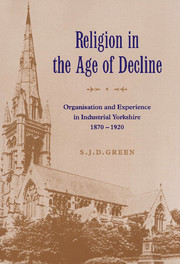Book contents
- Frontmatter
- Contents
- Acknowledgements
- List of tables
- List of abbreviations
- Introduction
- Part I Providing the means
- Part II Drawing in the people
- 4 The unfolding of the associational ideal: auxiliary organisations and ambitious societies
- 5 Learning advanced: the Sunday school movement, pedagogical innovation and the theory of juvenile religious development
- 6 Salvation extended: conversion, revivals and the unending mission to the people
- Part III The trials of the religious life
- Conclusion
- Bibliography
- Index
6 - Salvation extended: conversion, revivals and the unending mission to the people
from Part II - Drawing in the people
Published online by Cambridge University Press: 08 October 2009
- Frontmatter
- Contents
- Acknowledgements
- List of tables
- List of abbreviations
- Introduction
- Part I Providing the means
- Part II Drawing in the people
- 4 The unfolding of the associational ideal: auxiliary organisations and ambitious societies
- 5 Learning advanced: the Sunday school movement, pedagogical innovation and the theory of juvenile religious development
- 6 Salvation extended: conversion, revivals and the unending mission to the people
- Part III The trials of the religious life
- Conclusion
- Bibliography
- Index
Summary
Introduction: submission, consecration and the promise of salvation
Though Victorian churchmen and ministers often accused each other of bearing false witness, whether of preaching unsound doctrine or of practising unholy rites, their wrath, directed so vehemently against those who they presumed were condemning the innocent to eternal damnation, not only presumed the existence of one true and righteous path to salvation, but also presumed their own certain knowledge of how to follow it. And though they condemned each other's heretical deviation from its singular and pristine grace, Victorian and Edwardian churchmen believed implicitly that the road to personal salvation began and ended (at least in this world) in the bosom of the Christian Church. In this sense, they understood that to acknowledge Christ, to submit to Christ and to consecrate one's life to Christ was to be converted to Christ, and only in conversion to Christ in His Church was there a way to personal salvation. This view, albeit antagonistically expressed and exclusively interpreted, was true across denominations, for most ministers and amongst the majority of laymen. Even those who truly believed in dual-predestination rarely encouraged their flock to leave so great a matter entirely to God's deliberation. And even those who really upheld the priesthood of all believers seldom sought justification by isolated faith alone. Righteousness, generally conceived, was a common path. It was trodden by those who walked with Christ in the ways of His Church.
- Type
- Chapter
- Information
- Religion in the Age of DeclineOrganisation and Experience in Industrial Yorkshire, 1870–1920, pp. 256 - 290Publisher: Cambridge University PressPrint publication year: 1996



